What actually happened in Vietnam amid the Delta variant wave? How was a country that crushed the COVID-19 pandemic in the previous three waves brought to its knees? Journalist Linh Thuỳ Trương hails from Vũng Tàu, a small seaside city two-hours drive from Hồ Chí Minh – the economic hub of Vietnam. She looks back over her personal experience with Covid, and the massive challenges Vietnam has faced fighting the Delta variant.
Before the fourth wave of Covid hit Vũng Tàu city, life was starting to get back to normal.
After a few scares during the national Tết – Lunar New Year, the city was in good spirits as our province – Bà Rịa Vũng Tàu – announced the first vaccination roll-out for front-line workers in March.
Local airlines had also hoped to reopen international routes after the third wave at the beginning of the year.
The whole city was expecting a huge recovery for tourism in the upcoming public holiday – our Unification holiday at the end of April.
There were a few warnings of the risk of a national outbreak like that of India on the national main social media channel – Facebook.
But as the big holiday slowly approached, no one took them very seriously.
On the 24th of April, Vũng Tàu city launched Vũng Tàu Taste Week 21 – a local food festival as part of the province’s effort to recover the local tourism industry.
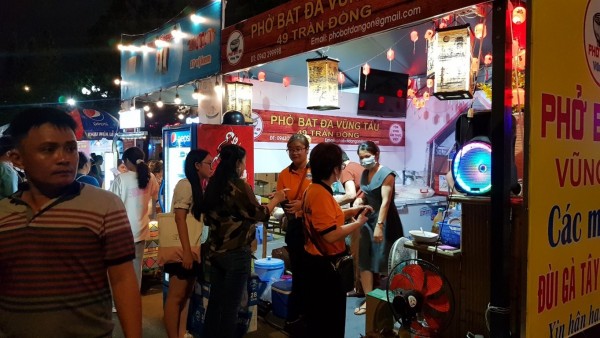
Our family business at Vũng Tàu Taste Week 2021
My family owns a small Phở restaurant, so we were rushing around preparing to launch our pop-up stall at the food fair.
Within a week, tourists from Hồ Chí Minh city (HCM) and nearby provinces flocked to the food festival, we were exhausted from running a full stall at the first weekend but the adrenaline from the huge sales bump kept us motivated.
But then the ongoing outbreaks of Covid in the North forced Hà Nội city to halt all festival celebrations on the 28th of April.
We were worried, but kept going as the dark cloud of Covid loomed on the horizon.
The Covid tornado.
One day later, Vũng Tàu city issued an official dispatch to stop all holiday celebrations and unnecessary businesses such as karaoke, dance clubs, bars, and beer clubs until further notice.
The food fair came to an abrupt stop on the same day. Many businesses were frustrated as their huge investment went down the drain.
On the 7th of May, the city decided to stop many more businesses and public-gathering events. Restaurants and cafes were allowed to open still but take-away was encouraged. We were open but there were few customers.
All schools and language centres were also closed, with kids studying from home as English and international-school teachers worried about future unemployment.
The 25th of May was our once-in-a-five-year national election. For the whole month, propaganda encouraging citizens to vote blasted all channels. As the election came closer, COVID-19 news was replaced with even more political propaganda.
Warnings of an imminent outbreak were quickly drowned out again.
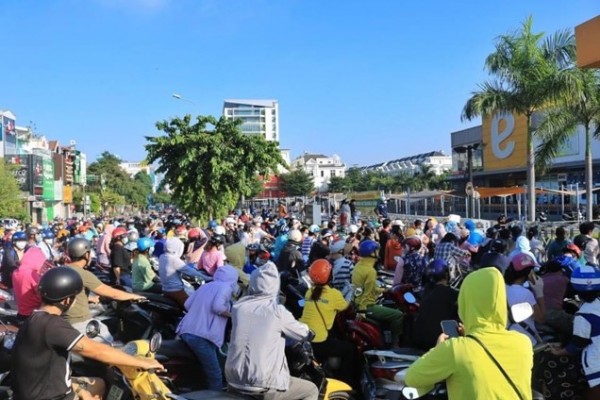
Residents of Ho Chi Minh City swarm a supermarket as panic buying took hold / photo supplied
There were also rumours about a nationwide social distancing order right after the election, but after three waves of COVID-19 and countless attacks of fake news, I was waiting for an official dispatch for confirmation.
Vũng Tàu city continued closing unnecessary businesses. Public-gathering of more than 20 people were banned, including inside restaurants and cafes for dine-in customers. After all the hard work for both the restaurant and her company, my mum ended up hospitalised in Hồ Chí Minh city.
Although travelling across provinces was not encouraged, she used her own car and went straight to the hospital. At that point, the hospital had already sent home all non-critical patients. My mum was pretty much alone in a huge but empty hospital, waiting for a doctor’s decision on whether she would need surgery.
The long wait was not ideal, especially when outside of the hospital, Hồ Chí Minh city was still at risk of new outbreaks.
The Bắc Ninh and Bắc Giang provinces in the North were now the COVID hot spots on the news, with the whole country following the skyrocketing daily case numbers as medical staff in the north volunteered to come for support. Covid tests ramped up to thousands of samples per day.
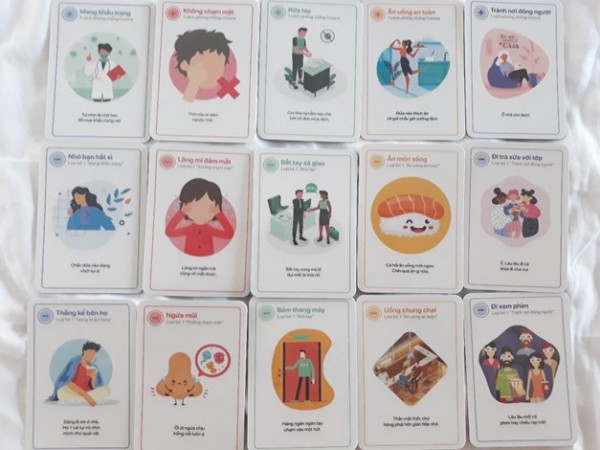
The Kovid cards - card game made by a local to educate about the 5K COVID-prevention methods/ photo supplied
Then a huge Covid pocket was found. HCM city immediately issued an official dispatch to implement social distancing, and Saigonese rushed out to supermarkets to panic buy food and provisions – the first time this had been seen in the city.
We used our car to get my mum back to Vũng Tàu to avoid being stuck alone in the hospital in Hồ Chí Minh for another two weeks.
Inevitably though, like a flood overflowing a dam, Vũng Tàu city started having a few cases relating to the Covid outbreak in HCM city.
On that same evening, the city found more than a hundred people had fled from HCM to Vũng Tàu to avoid the lockdown. Locals started panicking whenever they saw tourists.
Our restaurant closed, and we were eventually forced to deregister it as the weeks turned to months of closure.
Everyone was holding their breath, hoping for the national vaccination programme that has been prolonged due to lack of vaccines.
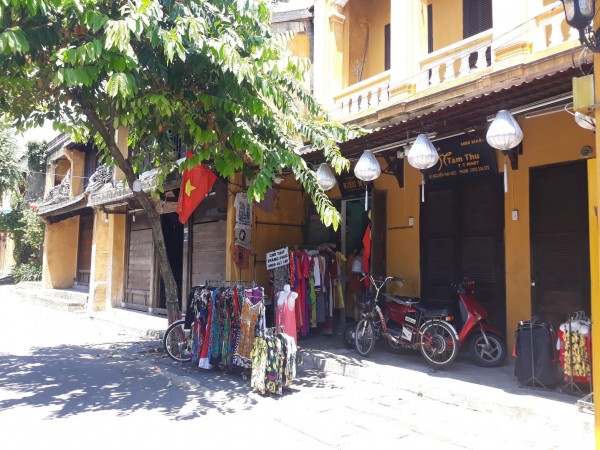
Hoi An's businesses are slowly reopening / photo supplied
Up until this point, Vietnam has been receiving COVID-19 vaccines through COVAX – WHO’s COVID-19 Vaccines Global Access – initiative. Unfortunately, we are not in the top tier when it comes to vaccine distribution.
We had not been able to produce our own vaccines. At the same time, we are not rich enough to hoard vaccines not needed immediately.
So, our only strategy was to hold out for as long as we can until the vaccines arrive. Sometimes that felt like a very long time.
With the risk of the virus looming in the corner, Bà Rịa Vũng Tàu province decided to be proactive with our attempt to access a vaccine source.
And by the 11th of June, we were the first province in the whole country to announce registration for COVID-19 vaccines from both the US and the UK for people who were willing to pay for the vaccination.
A month later the 11th of July, the province launched our own live COVID-19 map for the city – one of the first live maps in the country that actively and visually update everyone with the location and number of new cases in town. The province’s nimbleness filled everyone with hope and excitement.
Our cross-country move
On the 29th of June, Bà Rịa Vũng Tàu province extended the social distancing order for fear of infection from nearby provinces, and especially Hồ Chí Minh city. We still had close-contact cases relating to HCM, so the province had reason to be cautious.
Meanwhile, having observed erratic changes of the 4th wave for a while, my husband and I decided to push on with our move from Đà Nẵng following his new job in Hội An.
The city of Đà Nẵng had been one of the four main COVID-19 pockets of the country for a while and we were worried that if leaving it a few more weeks, we might end up being home quarantined or worst, government quarantined for a month.
But it was either then or never, so despite the uncertainty, we arranged a house-moving service and hired a private car to leave on the morning of the 5th of July.
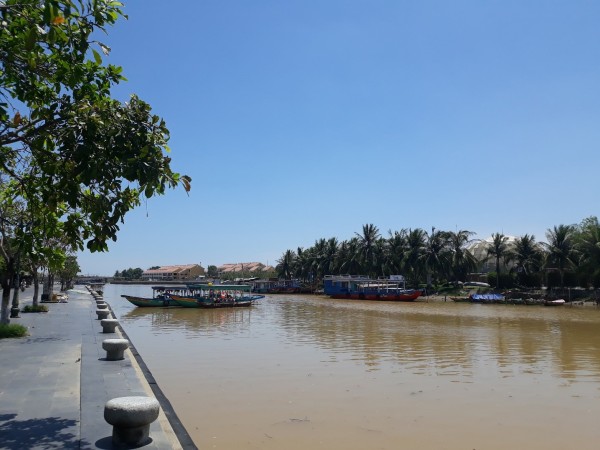
The empty Thu Bồn River in Hội An / photo supplied
As soon as we arrived in Hội An city, Vũng Tàu city started finding Covid cases in merchants who shop at Bình Điền central market in Hồ Chí Minh city.
The whole southern region then faced a battle with the Delta variant. We were relieved that we moved when we did.
Had we waited just a few days longer, we would have been sent to a government quarantine facility, also known as “Covid camp” for 14 days. Home quarantine in our new home in Hội An was a far better option.
Perseverance
In Hội An I started filling my days up with simple chores and job applications for remote work.
I still have remote work for my home family and a few writing jobs online that I started paying more attention to.
The expat community in Vũng Tàu has been super supportive of my translation work, and their acceptance gave me back a sense of purpose that I had missed.
Being busy again breathed a new life into me that even my husband recognised.
And what was better, on the 6th of September, Hội An lifted the latest social distancing order.
Restaurants and cafes started taking in onsite customers at 50% capacity. I went out to Highland café to work for the first time. I was nearly in tears when ordering food and the staff at the counter could not hide her happiness behind the mask either.
I took the time to visit the Ancient Town as well and observed first-hand the devastating effects of four COVID-19 waves in the once- prosperous tourist town.
Almost all shops in the Ancient Town have closed due to lack of tourists, shop owners who cannot afford the rent have left the town. Street hawkers have gone. The previous two times I had visited Hội An, during July 2020 at the beginning of the 2nd wave and in December of 2020, the Ancient Town was only sparsely opened, but this time, the town was truly dead.
I strolled down familiar roads that were empty with deep sadness.
The river was quiet as tourist boats soullessly docked by the bank without any person watching.
Except for lanterns hanging above the roads, there were no longer the vibrant arrays of lanterns, fashionable clothing, market stalls and the myriad of street hawkers selling Hội An’s signature dishes. I usually love strolling down empty streets, but for the first time, I did not enjoy what I saw at all.
As Hội An city has slowly reopened, the economy still needs time to recover.
But more shops and stores have slowly opened for business. I saw a few new clothes shops in the city’s centre. We have had a few dinners out in local restaurants and two weekends chilling in a café by the beach.
Our new life in this new town is slowly becoming a more pleasant one.
Vietnam faces the future
Things are starting to pick up across Vietnam as well.
In early September, many business groups in Vietnam, from small and medium businesses to FDI (Foreign Direct Investment) businesses started pushing for plans to reopen the economy.
On the 10th of September, Hồ Chí Minh city introduced a step-by-step plan to address that. A few districts in Hồ Chí Minh city such as District 7 and Cần Giờ have been green zones (safe zones without any COVID-19 cases) for a few weeks and started to loosen down the travel restrictions.
There has been a proposal to open Cần Giờ district for Saigonese tourists by the end of September, especially for the front-line workers who have been working hard to fight the pandemic.
As September has rolled on, some field hospitals in Hồ Chí Minh city observed a reduction of new cases to the point of thinking about closing.
We are starting to receive huge batches of pre-ordered vaccines from the US and the UK. Batches of vaccines as aid from Japan, Germany and Cuba have also arrived.
The Ministry of Health (MoH) has approved the clinical trial results of phase 3 of the Nanocovax vaccine, the Vietnamese homemade vaccine. On the 24th of September, we successfully produced the first batch of the Sputnik V vaccine in Vietnam.
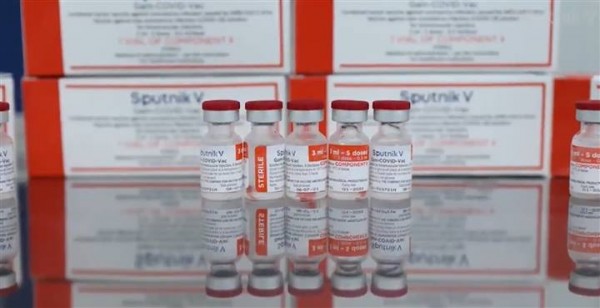
Vietnam is now producing the Russian "Sputnik" vaccine/ photo Sputnik
The 4th wave of the pandemic is still ongoing in Vietnam and the last nine months have been so eventful.
The local authorities, front line workers and many earnest volunteers have been working endlessly 24/7 every day, risking their lives against this dangerous virus to keep the infection manageable.
But our long struggle to hold out for the vaccines has finally borne fruit.
Things have moved so fast this September, it’s almost like a miracle!
We are also looking forward to more batches of vaccines finally arriving.
At the beginning of this pandemic, our Prime Minister, Mr Nguyễn Xuân Phúc said “chống dịch như chống giặc” – “this war against the pandemic is like a war against an invader”.
I have never experienced something as close to our ancestors’ war experience as this pandemic.
But just like many previous generations of Vietnamese, we will once again defeat the enemy and get back to life in a new normal.
The central region of Vietnam – Bình Trị Thiên - has this proverb :
“[…] Chớ than phận khó ai ơi
Còn da lông mọc, còn chồi nảy cây.”
“[…] Don’t whine about life’s hardships
If there is still skin, there will be hair, if there are still sprouts, there will be trees.”
Asia Media Centre